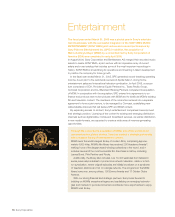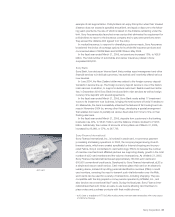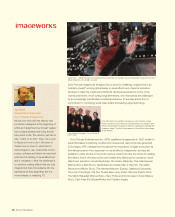Sony 2005 Annual Report Download - page 27
Download and view the complete annual report
Please find page 27 of the 2005 Sony annual report below. You can navigate through the pages in the report by either clicking on the pages listed below, or by using the keyword search tool below to find specific information within the annual report.
QRIO bipedal robot
R&D Expenses for the Fiscal Year under Review
R&D expenses for the fiscal year ended March 31, 2005, decreased 2.4%, to ¥502.0
billion, equivalent to 7.6% of net sales, excluding the Financial Services segment,
compared with 7.5% of net sales the prior year. R&D expenses in the Electronics
segment rose 0.8%, to ¥432.8 billion, while those in the Game segment declined
17.9%, to ¥68.5 billion. Approximately 62% of R&D expenses in the Electronics seg-
ment were allocated to prototype development and 38% to new, mid- to long-term
technologies focusing primarily on semiconductors, communications, displays and
next-generation optical disc technologies.
Long-Term Research Fields
In step with Moore’s Law,* semiconductor device development is evolving from the
“micro” to the “nano”** level as techniques for fabricating and measuring are increas-
ingly miniaturized. Miniaturization is expanding computing capacity, accelerating the
transition to broadband networks, and stimulating the electrification and digitization
of staggering volumes of information and content in the form of text, voice, still-image
and video data. Accordingly, information technologies are transitioning from “giga” to
“tera” and “peta.”**
Advances in processors, storage, networks and software will drive massive
changes in the computing environment, making it possible to run large-scale simula-
tions and process rich media applications in real time on a daily basis, impossible
until now because of a lack of computing power. In addition, Sony’s integration of
recognition technologies with IT will render communication between humans and
products/services more natural. In particular, it will enable the development of robots
that are more human-friendly.
We believe these technological trends will continue. Accordingly, in addition to
R&D for traditional devices that are viewed and interacted with as collections of many
molecules, atoms and electrons, we are starting to pursue research at a “nano-device”
and “nano-electronics” level into the qualitative characteristics of small numbers
of particles. Rather than relying solely on the top-down process represented by
traditional semiconductor processes, the fabrication of nano devices will combine
bottom-up processes in which the molecules align themselves. We are also venturing
into biotechnology and other areas, learning how to apply in our devices the qualities
of DNA—the legacy of evolution—and mimic the elegantly elaborate formation of
protein molecules.
We will continue R&D into these new technologies to facilitate their use in daily life
and enable us to offer products, services and entertainment that improve the quality
of life for people everywhere.
**Moore’s Law is the principle that the data density of integrated circuits doubles every 18–24 months.
** Micro=one millionth, nano=one billionth, giga=1 billion, tera=1 trillion, peta=1 quadrillion (1,000 trillion)
■ Electronics
■ Game
■ Other
Sony Corporation 25
600
450
300
150
02003
443.1
380.3
61.5
1.3
429.4
83.4
1.7
432.8
68.5
0.7
514.5 502.0
2004
(Yen in billions)
R&D expenses
2005
























